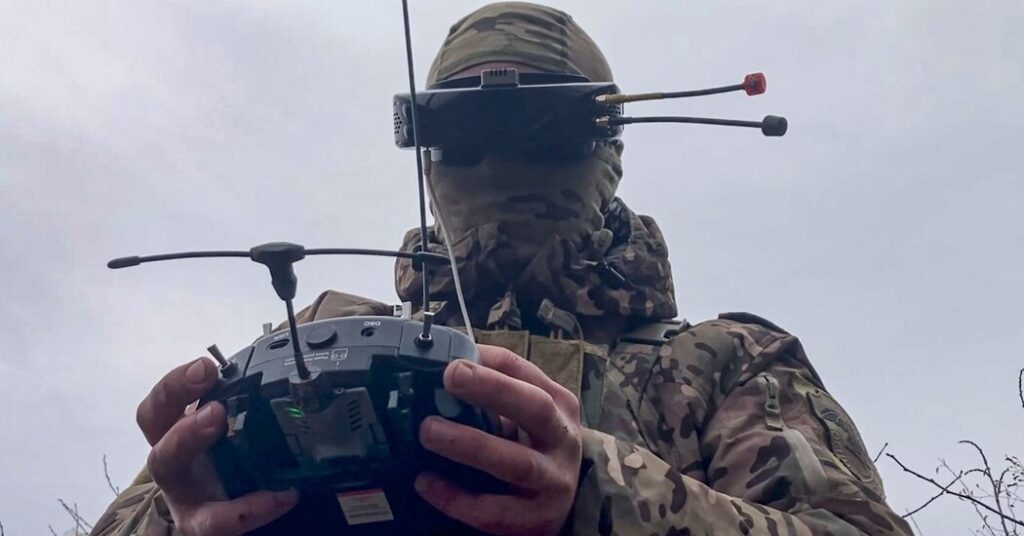It was a novel Ukrainian spy plot, inspired by what Israeli intelligence had pulled off with exploding wireless devices and Hezbollah militants: Hide tiny bombs in the goggles that Russian soldiers use to control drones. Donate those goggles to the Russian military, under the guise of humanitarian aid. Then wait for the explosions.
The Russian news agency TASS reported the suspected sabotage of the goggles earlier this month, and on Thursday, a senior Ukrainian official confirmed that Ukraine’s military intelligence agency, known as the HUR, developed the scheme. The Ukrainian news outlet Suspilne reported on the explosions earlier Thursday.
The Ukrainian plot did not have the same public results as the Israeli one, which killed dozens of people and wounded thousands across Lebanon, including civilians. While many goggle explosions were reported this month, the plot seemed mainly to make Russian soldiers wary about using goggles in the future, at least according to social media posts.
No one was reported injured or killed, although the Russian military does not often disclose casualty figures. The senior Ukrainian official, who spoke on condition of anonymity to discuss intelligence matters, told The New York Times that there were casualties, but he would not disclose numbers because the operation is ongoing.
The booby-trapped goggles were just the latest salvo in a long-running spy-vs-spy battle between Russia and Ukraine. Both sides have been accused of using operatives to kill military leaders and activists.
Ukrainian officials have asserted that Russia maintains a wide network of sleeper agents, and have variously accused a nurse, a church deacon, a high-ranking official in Ukraine’s intelligence agency. Russia has accused Ukraine of orchestrating the assassinations of prominent figures, including a general killed by a bomb in Moscow and an ultranationalist commentator.
The senior Ukrainian official said that the Ukrainians came up with the goggle idea after Israel appeared to launch its own Trojan Horse operation in September, forming shell companies to supply pagers to Hezbollah that then exploded, killing 20 and injuring about 2,700. The next day walkie-talkies belonging to Hezbollah members blew up, killing a dozen more.
The Ukrainians knew that Russians didn’t use pagers or walkie-talkies. Instead, they used a lot of first-person-view drones, or FPV drones, and the pilots needed special goggles to fly them.
On Feb. 7, a Russian named Igor Potapov, who says he works for a company that develops and supplies electronic warfare equipment, complained about a batch of altered Skyzone Cobra X V4 drone glasses manufactured in China. He claimed that a man named Roman donated them. In an interview, Mr. Potapov said he had heard about the goggles the day before he posted on Telegram, and had confirmed the rumor with a volunteer who helped the Russian army. The Skyzone Cobra goggles were popular with Russian operators because they were inexpensive.
Although it’s not clear how the goggles are detonated, Mr. Potapov said they exploded when they were turned on.
“Information about humanitarian sabotage has emerged,” he wrote, posting photos of the mailing label for the goggles and photos of the devices. “Glasses for FPV drones were received, when turned on, detonation occurs.”
Mr. Potapov also said in the interview that no one was injured.
A video showing the devices being dismantled had previously appeared on a Russian pro-war Telegram channel, called “Engineers to the Front.” The channel’s operators claimed that the goggles had been distributed through volunteers “without their knowledge,” and called the attempted attack “massive.” According to them, the Russian military complained about “multiple cases” of exploding goggles.
The channel reported that each device contained as much as 15 grams of plastic explosive and detonators. The explosives were packed into boxes fashioned with 3-d printers that were installed in place of a fan. The Engineers to the Front authors said the boxes for the goggles “showed subtle signs of being opened.”
Oleksandra Mykolyshyn contributed reporting from Kyiv, and Alina Lobzina from London.


